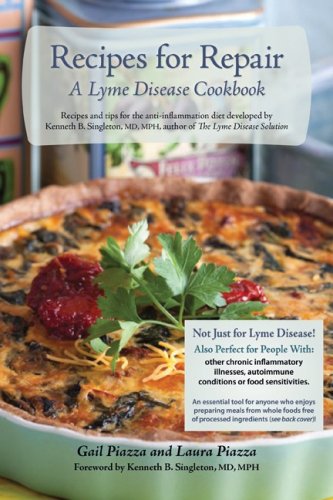Lyme disease is a growing concern nationwide and is exploding in New England thanks to the mild winter. A pair of local authors uniquely qualified to talk about the issue are joining forces to present a free discussion on Lyme disease at Gibson's Bookstore on June 23 at 11 a.m.
Katina Makris, author of Out of the Woods; Healing Lyme Disease, Body, Mind & Spirit, and Laura Piazza, co-author of Recipes for Repair: A Lyme Disease Cookbook, are both chronic Lyme patients who have suffered through the frustrations of continued misdiagnosis and the resulting personal struggles.
After years of failing to find the proper diagnosis, Makris – long-time natural health care practitioner – wound up bedridden, too weak to perform daily tasks, and eventually lost her job, marriage and financial stability due to the battle. She eventually found the proper care and has enjoyed a full recovery.
Piazza, too, struggled to receive the proper care, even after an initial Lyme diagnosis, and battled through more than 14 years before discovering the help she needed. Unlike Makris, though, Piazza's road to recovery continues.
The authors spent some time with the Insider in preparation for their upcoming appearance.
Because Lyme disease is often viewed as a New England-centric issue, do you hope to increase awareness of the disease beyond New England between the book and the presentations?
Katina Makris: Most definitely. I've already been to the West Coast with it, to California and Seattle, and I've got an article in a national organic farming magazine that goes nationwide. Also, my publicist with the book is trying to get it (mentioned) in as many highly visible publications as she can, nationwide, things like Huffington Post, etc., because Lyme disease as an epidemic may be most dense here in the New England area, but it's radiated out and leaked as far as the West Coast, and also to Texas and Florida because of migratory birds. It's in 89 countries in the world.
Laura Piazza: People tend to think it's only in New England, but it's in all states and all over the world. There is certainly a focus on it here, but there should probably be a focus on it anywhere, because it doesn't discriminate between state lines.
What was it like to have experienced Lyme disease? How does that experience influence the way you talk to/educate the public?
Makris: First of all, I have to say, I had a very severe case of Lyme disease that went undetected for five years, got into my nervous system and my brain. I was bedridden, and I suffered a huge amount of loss in my life – my career, my home, my income. It was really a full-life catastrophe. But I am fortunate, I am one of maybe 10 or 15 percent that's fully recovered from the chronic version of it.
When I'm speaking with people, it's very much about helping give them direction to get proper diagnosis, but also helping them find practitioners who can get them the help besides just killing off the infection. Some people have said to me that I am really in a very unique position as an author, because I'm a survivor, a patient, and a health practitioners, so I've got multiple lenses to look at this illness from and kind of give it a unique voice.
Piazza: I was misdiagnosed for 14 years and just got a proper diagnosis 3½ years ago. So it influences me because of my misdiagnosis. Looking back on it, I had all the telltale signs – I had the bullseye rash, I had a tick bite, I had the onset of symptoms – and it was really mismanaged by the medical professionals I had gone to. Knowing how my case was mismanaged and how easily that can happen and seeing how it can happen to other people, I like to pass along my story to help prevent it from happening to other people.
Lyme disease is sort of misunderstood and mysterious disease. How do you hope to change people's perception through the book and the presentations?
Makris: When they first identified the Lyme epidemic in the 1970s, at the time they thought it was a short-term infectious illness (that always presented with a bullseye rash). They thought it only had a couple of weeks duration and two weeks of antibiotics should take care of it. But years have gone by now and decades later, what they're finding out is only half the people or less get the bullseye rash. I never had it.
A lot of people feel like they are coming down with the flu or have stiff joints but don't have the rash, so they go to their physician and they don't even think to test for Lyme disease, so there's 50 percent of the cases right there flying under radar.
And the second piece is we now know that two weeks is insufficient, that people need six weeks (of medication) right up front. What happened is some people that even got antibiotics didn't get enough, and then what happens is six months, two years, three years later and you've got these weird symptoms, and the doctor says we gave the antibiotics so this is not Lyme disease, this is something else? So a lot of people get diagnosed with other things, like lupus, or MS or chronic fatigue syndrome, when really it could all be l inked back into the bacteria of Lyme disease. But they have not labeled the chronic version of the illness, so many doctors don't know what they're looking at. Some of them are driving in the dark.
Laura: I want people to realize that it can be chronic, and the wait-and-see approach I received when I went to doctor can be very dangerous, especially in this state, where with state testing, when ticks are tested they turn up to be positive for Lyme disease and other tick borne illness at least 50 percent of the time. That's pretty dramatic. I was talking to pest control professional in Milford and he said there was a certain spot in Bedford that was upward of 90 percent when testing ticks. With those odds, the wait-and-see approach seems kind of dangerous.
What was the lowest point in your journey? How about the highest point?
Katina: Rock bottom was the summer of 2005, when I was five years into it, when I was too weak to even get dressed or get a shower without help. I was really fractured physically and emotionally and really thought I was dying. I had all these strange palsies and neuropathies, speech impediments and dementia-type symptoms where I couldn't think of names and places. It was really frightening, and my spirit was really broken.
And when I really knew I was out of it and back to my whole self again was probably just last summer, in 2011, when I could swim outdoors in the pond, swim a mile every day without it being a problem. I just though, wow, I can swim a mile every day in open water. That was definitely a crowning moment, something very special. I was kind of working on it for two summers, starting with just a little distance to the buoy and back, so I kind of worked on it over a two-year period, and last summer I had a string of days about 10 in a row where I swam a mile every day on my own, in open water, and said, this is really pretty and amazing for me.
Why do you think Lyme disease is so difficult to diagnose? What are some of the concerns given that situation?
Katina: The two most important things for me is No. 1, proper diagnosis, which means you have to use state of the are Lyme testing labs. There are only three of them in the country, and the average physician doesn't necessarily know about them. And No. 2 is integrating the two hands of health care, which is pharmaceutical to deal with infection and the support of natural medicine to make it through the long haul and actually make it to a complete recovery, that you don't just get halfway well, you get all the way well. Those are my two hopes with the book, to help people get the proper diagnosis, and then also support so you can really reclaim your life.
Maybe something else to emphasize is not to think you are imagining things. If you feel the tests come back negative, and you still feel like you are sick, you need to find a Lyme-literate physician, because then you need to get a specialty test like I had. Lymenet.org is a great place to find the right doctors, and you can also visit lymedisease.org.
Laura: I think it's multi-faceted. There are a lot of misconceptions. Some doctors think you need to have the rash plus symptoms plus the evidence of a tick, when in fact if you are getting bit by a nymph tick, the smaller tick common in spring and summer, if the tick is somewhere hidden like in your hairline, it can feed for three to five days and fall off and you never realize you ever had it. Without the tick, it makes sense it could be misdiagnosed as the flu.
But I think with education, if people become educated about Lyme disease and the telltale symptoms of acute illness, they can be their own advocate. It's really about education. Looking back on this, my case was in my opinion mismanaged because I had all the things you'd expect: I brought the tick to the doctor, had the rash, had the symptoms, but in other situations that doesn't happen, people aren't fortunate enough to get the bullseye rash or see the tick, and I think that's where it really gets tricky. If you don't have the tick and get a flu-like illness in the spring or summer, you don't really think anything of it, but with education people can understand it, and if they were educated on the acute beginning symptoms, it would be a major benefit.






















